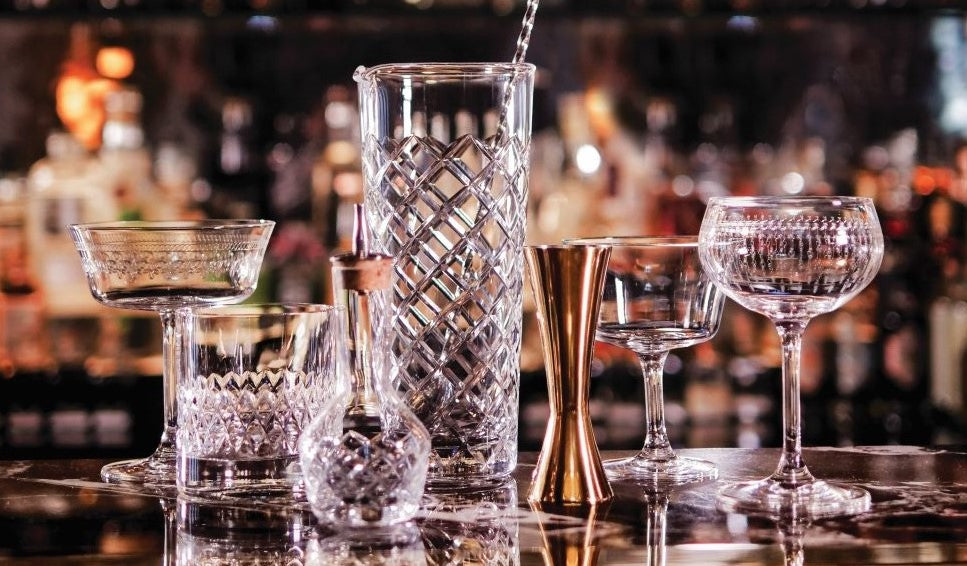Glassware: An Ultimate Exploration of Elegance & Functionality

Introduction:
In the realm of culinary aesthetics, glassware stands as an
embodiment of elegance, functionality, and artistic expression. From the
crystal-clear transparency of a water tumbler to the delicate curvature of a
wine glass, this comprehensive exploration unravels the intricacies of
glassware. Join us on a journey through the history, diverse types, materials,
and the evolving trends that shape the art of glassware in modern dining
experiences.
Historical Reverie:
The story of glassware unfolds across centuries, mirroring
the evolution of craftsmanship and societal preferences. Originating in ancient
civilizations, glass vessels were initially utilitarian. However, as
glassmaking techniques advanced, the artistry of glassware emerged. From the
ornate chalices of medieval banquets to the exquisite crystal creations of the
Renaissance, glassware became a symbol of refinement and status.

Types of Glassware
Tumblers and Highball Glasses:
Tumblers and highball glasses, versatile in their simplicity,
form the foundation of everyday glassware. These sturdy vessels are ideal for
serving water, juice, and a variety of beverages, embodying both functionality
and casual elegance.
Wine Glasses:
Wine glasses, with their distinctive shapes and delicate
stems, play a crucial role in enhancing the sensory experience of wine. From
Bordeaux glasses that accentuate red wines to tulip-shaped glasses for white
wines, the design of each glass aims to maximize the bouquet and flavor
profile.
Champagne Flutes:
Champagne flutes, characterized by their tall, narrow design,
capture and showcase the effervescence of sparkling wines. These elegant
vessels add a touch of sophistication to celebratory occasions, creating a
visual spectacle as bubbles rise to the surface.
Cocktail and Martini Glasses:
Cocktail and martini glasses, with their distinct shapes, are
tailored to the art of mixology. The wide, shallow bowls of martini glasses
allow for optimal chilling, while various cocktail glass designs complement
specific drink recipes, contributing to the overall drinking experience.
Beer Glasses:
Beer glasses, diverse in design to accommodate various beer
styles, are crafted to enhance the drinking experience. From pint glasses for
ales to tulip glasses for specialty brews, the shape and size of each glass
influence the aroma and flavor perception of the beer.
Materials
Soda-Lime Glass:
Soda-lime glass, the most common glassware material, is known
for its clarity and affordability. It is a practical choice for everyday
glassware, offering durability and versatility in design.
Lead Crystal:
Lead crystal, prized for its high refractive index, imparts
unparalleled brilliance and clarity to glassware. While exuding sophistication,
lead crystal glasses are often reserved for special occasions due to their
delicate nature.
Borosilicate Glass:
Borosilicate glass, celebrated for its resistance to thermal
shock, is often used in glassware designed for hot beverages. This resilient
material allows glassware to transition seamlessly from hot to cold
temperatures without the risk of breakage.
Colored and Textured Glass:
Glassware enthusiasts and designers embrace colored and
textured glass for its ability to add artistic flair to table settings. From
vibrant hues to intricate patterns, these glasses become focal points,
contributing to the overall aesthetic of the dining experience.
Evolving Trends in Glassware Design
Minimalist Elegance:
Modern glassware trends often lean towards minimalist
elegance. Clean lines, simple shapes, and monochromatic designs create a
contemporary aesthetic, allowing the focus to remain on the beverage within.
Mixing and Matching:
Mixing and matching different styles of glassware has become
a popular trend, allowing individuals to curate eclectic table settings.
Combining various shapes, colors, and textures creates a dynamic visual
narrative.
Personalized and Glassware:
The demand for personalized and customized glassware has
surged, with individuals seeking unique statements for their dining
experiences. From engraved wine glasses to bespoke cocktail tumblers,
customization adds a touch of individuality to the table.
Functional Considerations:
Beyond aesthetics, the functionality of glassware is
paramount. Factors such as rim shape, bowl size, and stem length are designed
to enhance the drinking experience. Understanding these considerations allows
enthusiasts to choose glassware tailored to specific beverages and occasions.
Caring for Glassware:
Proper care is essential to preserve the brilliance of
glassware. Handwashing with mild detergent, avoiding extreme temperature
changes, and handling delicate crystal with care are key practices to extend
the lifespan and luster of glassware.
Conclusion:
In the orchestration of a culinary masterpiece, glassware stands as both canvas and vessel, framing the sensory experience of each sip. From the humble tumbler to the exquisite crystal flute, glassware reflects the artistry of craftsmanship and the evolving tastes of society. As we raise a glass in celebration, whether adorned with simplicity or intricate brilliance, let each vessel tell a story – a story of elegance, functionality, and the timeless art of dining. Cheers to the enduring allure of glassware in the grand tapestry of culinary exploration!









